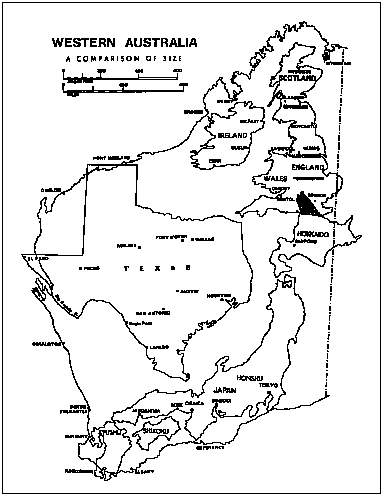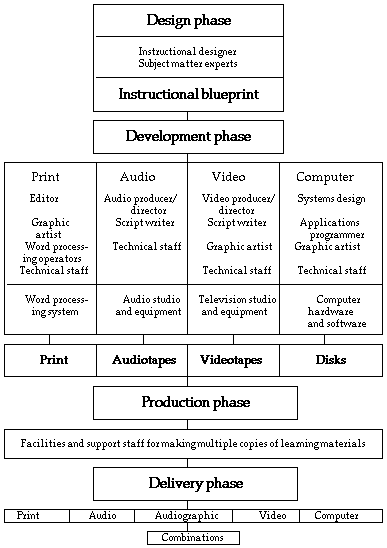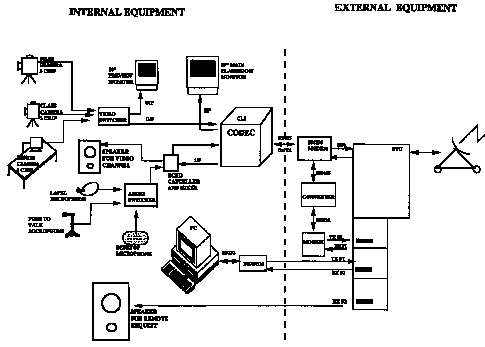
 |
Add to these challenges the equity and access issues associated with providing training services to a vast state (Figure l) with relatively few large regional centres (population 15,000 to 25,000) and the need to exploit alternative delivery strategies becomes obvious. Open learning, in all its forms, when incorporated within the mainstream of education and training has the potential to

Figure 1: Western Australia - a comparison of size
A unique funding model was developed which emphasised the joint venture nature of the project and drew on the following sources.

Figure 2: West Pilbara centres
Communication systems, computers and other innovations were once seen merely as a means of compensating for what was missing in traditional training and education for remote schools and colleges. The deficiency model of distance education is an obsolete way of evaluating learning through technology. This obsolete model was based on experience in correspondence courses, where
Many discussions and papers on educational teleconferencing tend to focus on the nature of the technologies, the newest video codec, the relative merits of various bandwidths, or the potential of optical fibre versus satellites. While this may be interesting, it is not very important when it comes to actually using teleconf-erencing for education and training. What is important, is an understanding of the special attributes of the various forms of teleconferencing and how these attributes can be exploited through creative educational designs.

Figure 3: Instructional materials design, development and production
infrastructure (modified Uni College of Southern Qld model)
Video conferencing is not broadcast television nor is it videotape production. It can be a simple substitute for the classroom and its whiteboard, but it can also be much more. It is not a new medium but its successful application in training situations challenges our instructional designers to think creatively.
The course development model (Figure 3) favoured by participants in LIVE-NET embraces the whole range of teaching roles from design through to final delivery of the material to the learners. In reality, Figure 3 is a description of the roles that every effective instructor plays. Whenever we teach a class on our own, we must act as a course designer, editor, script writer, graphic artist, producer, director, and presenter despite our lack of specific skills and training in these areas. The solitary approach is onerous and instructors are encouraged to team develop courseware via interactive workshops.
The guiding principles of tele-education via LIVE-NET are
The signal from a video camera is fed into a codec (coder-decoder) at the sending end. A complex computer program in the codec removes some of the information so that the total signal content is reduced (compressed). A codec at the receiving end reconstitutes the signal. Intelligibility of the image is not lost but it does mean that movement is affected. Care must be taken to ensure that the original image being captured is suitable for transmission, as rapid movements can cause a break-up of the image. For example, a video cassette of a movie could not be transmitted successfully using compressed video, but a lecturer wearing appropriate clothes and addressing a camera as well as or instead of a class in front of the camera could achieve very satisfactory results.

Figure 4: Equipment configuration
| MAIN MONITOR | a classroom size monitor (29 inch or better) (video projector in Paraburdoo) |
| PREVIEW MONITOR | 14 inch monitors in Tom Price and Paraburdoo, 29 inch monitors in Perth and Karratha |
| MAIN CAMERA | a 3-chip CCD camera plus lens and power supply |
| BENCH CAMERA | a 1-chip bench camera plus lens and power |
| CLASS CAMERA | a 1-chip CCD etc. (Perth and Karratha only) |
| SPEAKERS | loudspeaker(s) adequate for incoming audio |
| MEETING MIC | a desktop microphone |
| AUDIENCE MIC | a push to talk microphone |
| LAPEL MIC | for trainers and presenters (Perth and Karratha) |
| CONTROLS | video and audio switching systems that allow the model of operation with Chairman controls in Perth and Karratha only. |
The instructor has a lapel microphone attached to his or her shirt. This not only ensures a better sound pick up, it helps keep the presenter from wandering off camera. The face to face audience will have a hand held push to talk (PTT) microphone which will be passed from person to person when someone wishes to make a comment or ask a question. PTT microphones are "dead" or off, unless a button is held down.
The instructor is able to select which site is transmitting the video signal. At the distant sites, the audience faces the main monitor, with the main camera mounted on top and focused for a fixed shot of the entire group. The preview monitor is used for the outgoing signal from the main camera or bench camera. Participants at the distant sites use the hand held push to talk microphone, passing it from person to person as the need to ask a question or make a comment arises (Figure 7).

Figure 5: Multipoint operation

Figure 6: Room configuration at a teaching delivery site

Figure 7: Room configuration at a receive site
| Computing Plant maintenance Mathematics Small business management Office and secretarial studies Banking practices Job and task analysis Training needs analysis Workplace change management Communications Psychology Languages Total quality management Painting and decorating |
Hospitality Accounting and Business Child care Mining hydraulics Nursing Award restructuring related training Skill profiling and audits Job design Ergonomic control of productivity Economics Philosophy Geoscience Time management Social science |
The Central Metropolitan College is presently developing several Jobtrain and Traineeship initiatives which can be targeted on client groups in the Pilbara and has prepared several staff development packages for lecturers involved in the project.
Courses offered on the network will be varied and will include
Australia's Department of Defence has installed its own two way, desk top video conferencing system linking the Forces Chief in Canberra with Maritime Headquarters (Potts Point), Land Headquarters (Victoria Barracks) and Air Headquarters (Glenbrook) in a secure network for regular management meetings and group briefings.
The Australian Stock Exchange has used two way video for weekly meetings for the past six years. Corrs Law Firm uses its own in house video system for partners' meetings and various committees of their Australia wide practice. Phillips Fox use ad hoc services (AAP Reuters) for similar purposes. National Mutual uses ad hoc video conferencing to gain a competitive edge. Just after the stock market crash, they brought two head office experts to Perth to train agents about the effects on financial planning, particularly superannuation. They were able to include all of their country agencies in the training via a GWN video conference. Wesfarmers Rural uses video conference meetings with its regional managers as a part of an integrated strategy that also includes audio conferencing, computer links and face to face meetings. Palmer Tube Mills, a Queensland company, regularly conducts the board meetings of its Chicago based subsidiary via OTC's compressed video service.
The WA Fire Brigades were the first in Western Australia to use open broadcast video conferencing to educate the general public and keep them informed. They now run four video conferences a year on fire dangers and preventative methods. The Catholic Church, the Education Department and the Department of Community Services have also used this approach. The Queensland Health Department used video conferencing to explain the dangers of the AIDS epidemic, and some preventative measures, to people in remote areas. The Family Medicine programme in Queensland has held a monthly video conference since 1986, to provide rural and remote members with professional education and consultancy services.
The Australian Teachers' Federation used one way video in February 1990 for a meeting of over 100 000 teachers throughout Australia via Sky Channel and local pubs and clubs. Return audio was through dial in telephone calls. Schoolmates was a 1988 two way video link among four schools in Sydney, Melbourne, Canberra and New Jersey (USA). The video conference served as the culmination of a year of interaction by text and audio conferencing.
The Centre for Advanced Learning Systems (CALS) in the Adelaide College of TAFE has established a three site video conference system with locations in Adelaide, Clare and Barossa Valley. Some 20 hours per week of TAFE courses are now carried on the system. Victoria's Vistel network is beginning to be used by universities and CAEs for experimental lectures, tutorials and class planning sessions. The TAFE Off Campus Network in Victoria uses video conferencing to take adult education, especially literacy and numeracy courses, into the state's prisons, including high security installations such as Pentridge. The newest experimenter is Deakin University's School of Management for the Master of Business Administration course.
IBM has installed its own 28 site video conference system for regular staff development and customer training. Called ISEN (Interactive Satellite Education Network), it teaches over 300 000 people a year. IBM Australia has replicated the American system, with one of the sites being located in Perth. The Australian system will soon expand to deliver IBM training across South East Asia. (Refer also to Cheng, 1990, in this volume.)
Central Maine Interactive Telecommunications System, a two way video system begun in 1977 with six hospitals and one university, is now connected to similar systems in other counties to give a state wide network. INTERACT, begun in 1968 with a two way video link between the Dartmouth Medical School and the Claremont General Hospital, grew to ten sites (including a maximum security prison) by 1974 and now links hospitals, medical schools and clinics throughout Vermont and New Hampshire. Health Communications Network, began in 1969 with audio links among four South Carolina hospitals and the Medical University, and had grown to video links among 31 hospitals and medical schools by 1983.
German By Satellite, from Oklahoma State University's Professor Harry Wohlert, has over 2200 high school students in one video conference class, spread over 304 schools across 15 states. Since none of the schools have enough interested students to justify hiring a German teacher, if it were not for Professor Wohlert, these students would not be able to study German. Each school's contribution for the video course is cost effective. The Irvine Interactive Cable Project connected two primary schools with two way video in 1974, with the network growing to 21 sites in 1978 and 30 in 1971. In addition to educational uses, government agencies buy time on the system outside school hours.
The National Technological University (Ft. Collins, Colorado), provides five masters degrees (computer science, engineering, etc) via video conference to over 200 sites, using top professors from 24 universities across the USA. California State University at Chico provides upper division and master's degree courses via video conference to student homes in Northern California by closed circuit broadcast system, and to 26 Hewlett Packard offices across America by satellite. Ball State University provides an MBA via video conference to students across America, via public broadcasting and pay TV stations. Numerous other tertiary institutions in the United States and Canada have been active in the video conferencing area for many areas, including Mt St Vincent University (Nova Scotia), Pennsylvania State University, George Washington University (Washington) and many others.
EUROPACE (European Program for Advanced Continuing Education) is a video conference network supported by 12 large computing and communications companies (IBM, Siemens, etc) and by the European Commission to provide leading edge coursework in high technology subjects. The Knowledge Network of the West in Canada (and many public television and cable or pay TV stations in America) use broadcasting for a wide range of direct to home adult education courses, from astrology to zoology.
Johnson and Johnson needed video conferencing among its agencies, marketing and research branches to manage the crisis when their Tylenol product was poisoned. Two way video was used both for in house planning and for liaison with retailers, police and health authorities. Boeing Aircraft set up a video conference network for the development of the 757/767 aircraft, connecting their Puget Sound offices with testing sites. They estimate a savings of 1.25 million local travel miles, but the main value of the system was the ability to make better design decisions more quickly.
No one disputes that both systems (lecture and tutorial) are needed. There are sound financial and pedagogical reasons to use one way video systems to reach large audiences in many sites across the state with identical information. There are also sound financial and pedagogical reasons for wanting to be able to observe student behaviour, see student products and allow students to make demonstrations or present reports.
However, until recently, two way multipoint video has been too expensive for telemeetings. That is all changing with the development of new codec algorithms. The technology costs have fallen 50% in the past three years and will continue to fall. As a result, use of two way video will grow dramatically in the next few years.
For the next six months, LIVE-NET participants will be the pioneers in multi point two way video conferencing. Adelaide TAFE (with locations at Clare and the Barrossa Valley) is the only other Australian educational institution experimenting with the technology, although there are a growing number of in house two way video networks in Australian companies that are used for training at least part of the time. The University of New England and Victorian institutions on Vistel are only experimenting with point to point video teaching at present.
Computer based technology will bring video conferencing to every office, even every desk, within the next ten years. Relatively cheap PC based video codecs are already nearly as good as the larger, more expensive ones. Coupled with "voice too" modems and the coming of ISDN (Integrated Services Digital Network), access to voice mail, computer bulletin boards and itinerant broadband capacity, a simple PC or computer terminal will allow you to dial up whatever type of conference you think will best suit the subject of discussion and the people involved.
There are a number of other technologies and techniques which are gradually being adapted into education and training that will make teaching easier, more accessible, more efficient and more effective. A number of us are already tackling some of them, such as computer managed learning and interactive videodiscs.
Our experience with LIVE-NET will be another step in the general preparation for dealing with technological change, making it easier to adapt the excellent teaching, training and management skills we already have to the new technological environments of the future.
Lundin, R. & Lange, J. (1990b). Tele-training: Education through video conferencing. Brisbane: Centre for Interactive Technologies and Programs, Brisbane CAE.
Coxon, S. (1988). Introduction to the IBM Interactive Satellite Education Network. IBM Australia Ltd.
Deckers, J. & Sharma, R.D. (1988). Support systems for external students - trends and emerging patterns. Paper presented at the Australian Committee of Directors and Principals and the Australian Distance Education Consortium Conference, Towards a student support system for distance education. Canberra, 16 June 1988.
Foks, J. (1988). Open learning in the State Training System: A report prepared for the General Managers of the State Training Board and Portfolio Resources Coordination Division. Melbourne: Ministry of Education.
Report of the WESNET Working Party. (1986). WESNET - WA Educational Satellite Network. Perth: Department of Computing and Information Technology.
Mitchell, J. (1989). Progress report on the Light College Adelaide College Video Conferencing Network project. Adelaide: Educational Innovations Occasional Paper No.15 November 1989.
Zimmer, M.B. (1988). A Practical guide to video conferencing. Training and Development Journal, 42 (5), 84-87.
House of Representatives Standing Committee on Employment, Education and Training. (1989). An Apple for the teacher - choice and technology in learning. Canberra: AGPS.
| Author: Graeme Davy lead the establishment of the Pilbara video conference network, as Director of Karratha College. He also played a leading role in the establishment of regional college contracting of higher education courses during his directorships at Great Southern Regional College and Karratha College.
Please cite as: Davy, G. (1990). LIVE-NET: The Pilbara Video Conference Project. In R. Atkinson and C. McBeath (Eds.), Open Learning and New Technology: Conference proceedings, 93-112. Perth: Australian Society for Educational Technology WA Chapter. http://www.aset.org.au/confs/olnt90/davy.html |